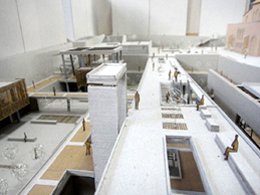STUDENTS PROJECTS
PROJECTS2012

18 May, 2013
Redesign of the Makedonomachon Square. Subway station ‘Agia Sofia’
The subway station as an extension of our social-cultural life.
Students : Polyxeni Douitsi, Maria Kritsioudi, Meropi Eleni Skordalou
Assistants : Panagiotis Gouliaris, Maria Grigoriadou
Supervisor : Dimitrios Polychronopoulos
Democritus University of Thrace
Presentation date : 17/07/2012

The two entrances, one being the main entrance and a secondary one, are on either side of the central 'Egnatia Street'. The intervention that we suggested expands from the upper levels of the entrances up to the tickets sale booths that stand just before the boarding platforms of the trains. Additionally, we tried to find the greater relationship between this contemporary installation with the ancient ruins found in the region [across the Egnatia Street] and the 'Makedonomachon Square', a park next to the main entrance of the subway station. Before the initial design phase, we examined all the issues necessary to understand the needs of the broader urban fabric. Immediately after, we defined the position of the subway station in the Makedonomachon Square and tried to lay down our initial design in correlation with the Byzantine temple, a characteristic monument that is part of the park. The main subway station area was designed as an open square in a lower level than the surrounding park. Central idea of the architectural composition was to preserve and emphasize the monumental ancient ruins. It was believed that the best way to achieve that was to design the subway station as an open museum. We wanted our design to serve as shrine to civilization which will attract not only the passengers but also the residents, serving as cultural center for the whole community. In addition, the surrounding area has been intensively planted, aiming to create a feeling of an oasis, as that it provides a place of serenity, where somebody could hide from the chaotic rhythm of the city. Apart from the museum and the exhibition booth we installed in order to create a place where parts of the ancient ruins will be exhibited, a number of different facilities [e.g. dinning, sanitary, shops] have been included in the project, to satisfy the daily needs of the passengers and residents alike. The connection between the Egnatia Street and the Makedonomachon Square is done through an inclined roof construction that allows visitors a top-down view on the plaza and the museum. This construction is a main part of the synthesis as it absorbs all the possible motions in the area not to mention that it connects the two entrances in the level of the tickets. This is why the basic stairwells are found there. Finally, the whole synthesis has been designed with such a manner that seems to be a unified surface. The eligibility of the materials and the organization of the squares and buildings according to the same alignments led to that direction.








Related articles:
- Architectural experimentations in the public. ( 07 January, 2009 )
- Art Center in Lamia ( 17 October, 2010 )
- Μemory hole ( 31 October, 2010 )
- A4: Cutting, Folding, Joining ( 10 January, 2011 )
- Crescendo creators ( 17 September, 2011 )
- “Paramana” Square ( 04 July, 2011 )
- Madrid RIO ( 25 August, 2011 )
- Formation of Central Nikis square, Kozani ( 23 July, 2011 )
- Architectural Competition for the Redesign of the old GSP Area (κ.71117) ( 06 December, 2011 )
- Metropolitan Park in Thessaloniki ( 20 December, 2011 )
- Architectural Competition for the Redesign of the old GSP Area ( 07 January, 2012 )
- Redesigning Klafthmonos Square ( 26 April, 2013 )
- Μultilayered square in Fira, Santorini ( 30 April, 2013 )
- Next station : Zografou station – Gardenia square ( 08 June, 2013 )
- Model urban agricultural park ( 09 June, 2015 )










